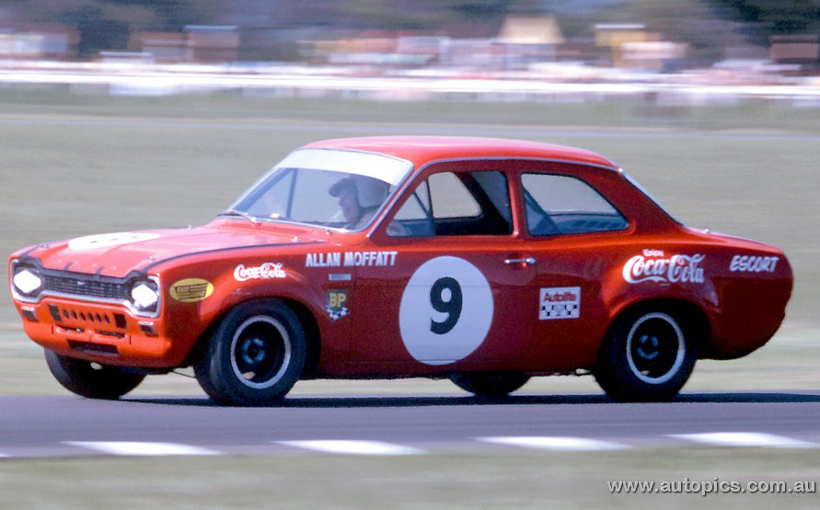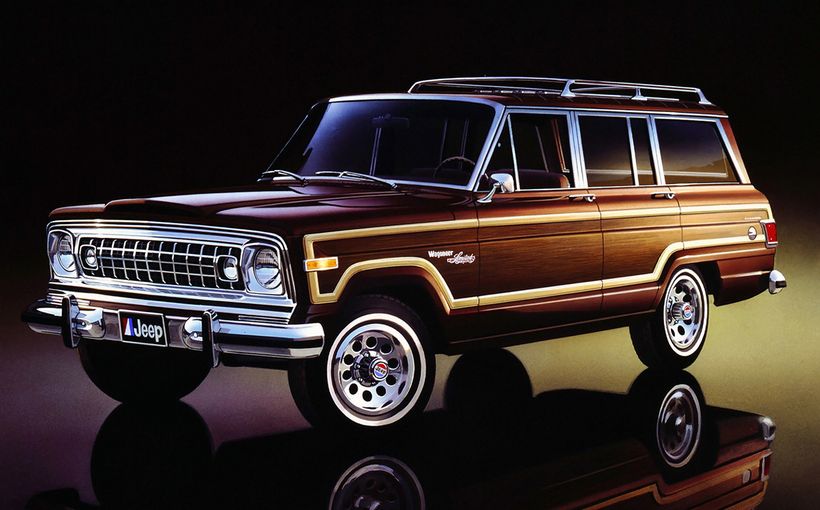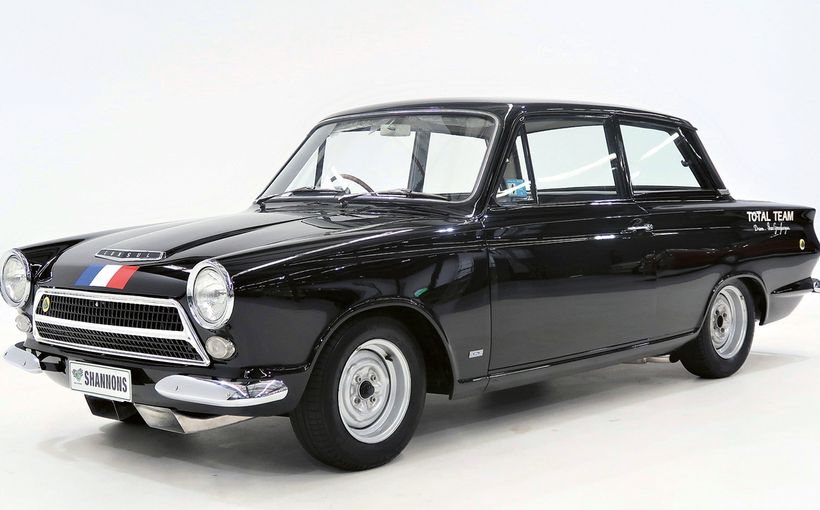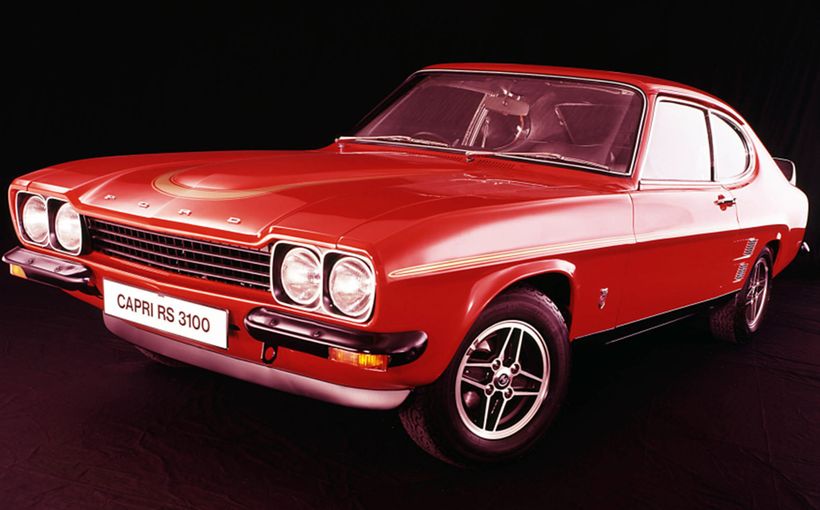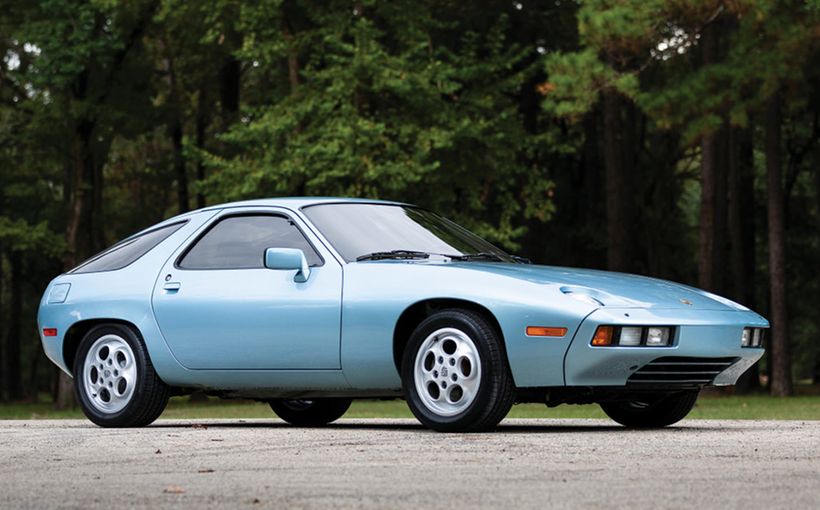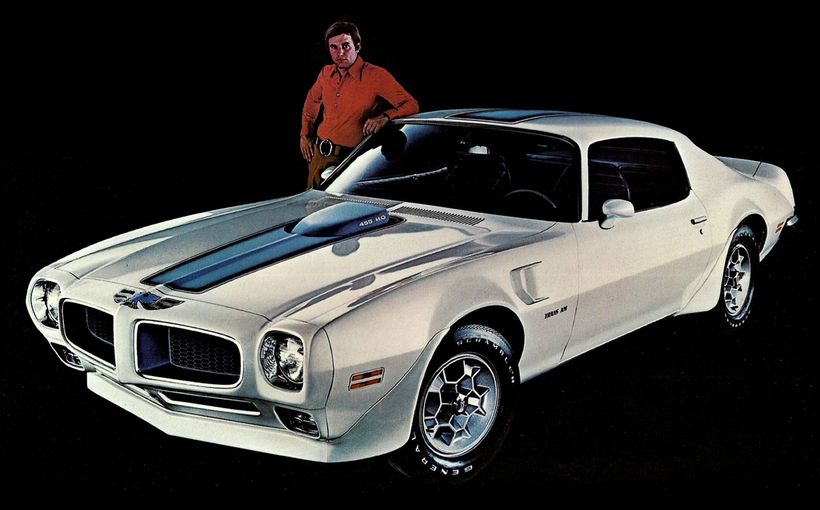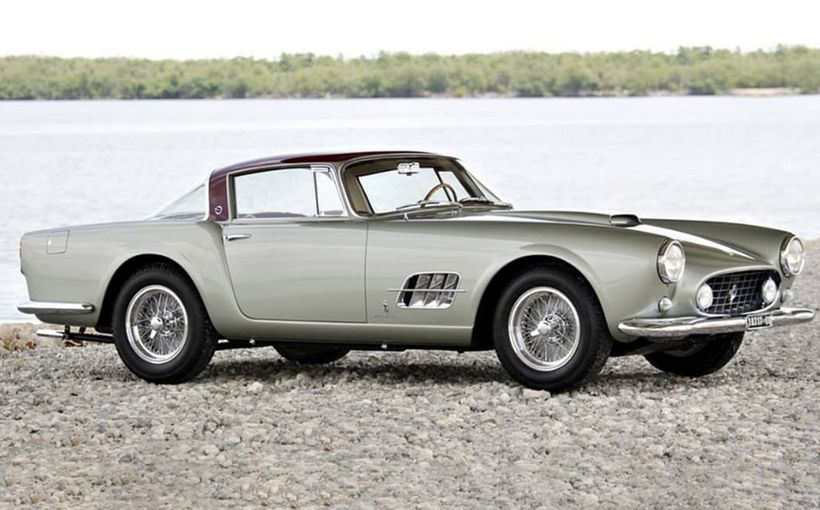Ford Escort Mk 1: Born to Compete. Bred to Win.
By
MarkOastler -
17 February 2015

Ford star Allan Moffat was the most high profile driver to race an Escort in Australia, when he drove this superb ex-Alan Mann Racing Cosworth FVA-powered version in the early 1970s. Here the Escort is captured in full flight at Sydney’s Warwick Farm Raceway in early 1971, just after it had been repainted in Coca-Cola red. Note how the sign-writer misspelt the driver’s name. Not a Ford fan obviously.
When a hot Twin Cam model was revealed only two months after the all-new Escort’s UK launch in 1968, Ford’s sporting intentions were clear. What followed was a series of brilliant competition-bred Escorts that would take the motor sport world by storm.
The stylish newcomer offered a choice of robust ‘Kent’ cross-flow four cylinder engines in a light but rigid unitary body-shell. MacPherson strut front suspension, a conventional leaf-sprung live rear axle plus rack and pinion steering resulted in a rugged but simple car that was a born athlete.
The catalyst for the Escort Twin Cam was Ford’s concern that its larger and heavier Cortina Mk 2 could not maintain the competitive edge of its Mk 1 predecessor. The Twin Cam was developed in remarkably short time by Ford’s Advanced Vehicle Operations (AVO) at Boreham, Essex and immediately proved a prolific winner in local and international racing and rallying.
More high performance Escorts were developed under Ford’s Rallye Sport or RS banner sold through a network of specialist Ford RS dealerships in Britain and Europe. These cars were built in the UK on an exclusive AVO assembly line in sufficient numbers to meet FIA requirements for competition use.
These included the RS 1600 released in 1970 with a Cosworth-designed 1.6 litre DOHC 16-valve engine. In 1973 the RS 2000 also joined the Rallye Sport stable, powered by Ford’s larger 2.0 litre SOHC ‘Pinto’ four. Both models and their numerous race and rally derivatives would bring unprecedented motor sport success for Ford.
In early 1975 the AVO assembly line in the UK was shut down, largely due to the global oil crisis which crippled Ford’s RS sales. All future Escort RS production, by then focused on the latest Mk 2, shifted to Ford’s mainstream plant in Germany.
More than two years after its UK launch, the Escort Mk 1 went on sale in Australia in 1970. Although the Twin Cam model (later badged GT 1600) was sold here through Ford dealerships, local showrooms missed out on the hotter RS 1600 and RS 2000 models.
Even so, due to its dazzling international reputation, there was no shortage of hot Escorts competing in motor sport events across Australia from grass-roots clubbies to national championships. Although it’s impossible to cover them all here, we’ve assembled some of the most successful ‘Aussie’ Mk 1 Escorts from the golden 1970s era.

Frank Gardner in his Alan Mann Racing Escort FVA sweeps through Copse Corner at Silverstone on his way to a famous victory in the 1968 British Saloon Car Championship. Note the decals on the front of the AMR cars which resembled UK road registration plates. XOO 349F was Frank’s British championship winner. Image: www.chromjuwelen.com
Frank Gardner’s Alan Mann Racing FVA
Aussie international Frank Gardner was one of Australia’s most successful motor sport exports. He amassed a staggering record of local and international success in touring cars, sports cars and open wheelers in a career spanning several decades as a driver and later team manager.
Gardner’s contact with the Ford Escort came through his association with Alan Mann Racing which served as Ford’s UK works team in a stellar period from 1964 to 1969. Gardner drove numerous cars for AMR, a highlight being the team’s old US Falcon Sprint rally car he developed into a top racing sedan to win his first British Saloon Car Championship (BSCC) in 1967.
In 1968 the first batch of Escort Twin Cams built at Boreham were designated as factory competition cars, with most destined for rallying. A small number were also earmarked for Alan Mann Racing to compete in both the BSCC and European Touring Car Championship.
Although built purely for racing purposes, these AMR Escorts displayed what appeared to be UK road registration plates. For spectators these plates (actually decals) maintained a visual connection with the standard road cars on which they were based and served as valuable reference in identifying each chassis.
Both the 1968 BSCC and ETCC were run to the FIA’s liberal Group 5 regulations, but European interpretation of the rules was different to that of the Brits particularly in relation to the number of engine valves permitted. Therefore the AMR Escorts ran with two-valve Lotus Twin Cams in Europe while the British cars ran exotic four-valve Cosworth engines.
As a result, the AMR cars that competed in the 1968 BSCC were among the greatest circuit racing Escort Mk 1s ever built. Gardner’s car (rego XOO 349F) quickly established the Escort as a giant killer as it cleaned up its V8 competition to win Britain’s most prestigious tin-top title outright with a string of class wins.

Castrol boasts a rich motor sport heritage and backed Frank Gardner during his international racing days. The specialist oil supplier produced this superb cutaway of the Aussie’s 1968 BSCC-winning FVA to celebrate his giant-killing victory. Such artwork provides a rare insight into the huge number of ‘Mann’ hours that went into creating these hand-built racers.
Finished in glorious red and metallic gold AMR colours, XOO 349F was as ‘trick’ as they come. It was blessed with agility and roadholding that appeared to defy the laws of physics, allowing the talented Aussie to often go wheel-to-wheel with the big American V8s chasing outright wins on some tracks.
The original two-valve Lotus Twin Cam was replaced with the famous Ford Cosworth FVA, or Four Valve type A. This dry-sump, 16-valve, 1598cc inline four was developed at around the same time as the legendary Ford Cosworth DFV (Double Four Valve) 3.0 litre V8, which became the most successful Formula One engine of all time.
The FVA was created for European Formula 2 racing in which it proved unbeatable, winning every F2 championship held from 1967 to 1971 or the duration of the 1600cc engine rules.
The FVA’s big-breathing aluminium cylinder head was the secret to its success, with gear-driven twin overhead camshafts (like the DFV), four valves per cylinder, 12:1 compression and Lucas mechanical fuel injection. Its neat packaging had the fuel injection metering unit driven by gear and belt from the inlet camshaft and the alternator located at the rear of the head driven by the exhaust cam.
The screaming FVA pumped out 218 bhp at a spine-tingling 9000rpm with 132 ft/lbs of torque tapped at 7200 rpm. The car’s battery and oil tank for the dry sump lubrication system were both moved to the boot for neater packaging and better weight distribution.
A competition clutch and lightweight magnesium alloy bell-housing were mated to a five-speed racing gearbox, running straight-cut gears and rugged dog-clutch engagement for the lightning-fast changes Frank needed to keep the high-revving FVA in its 8500-9000 rpm sweet spot. With tall gearing, this little 1.6 litre missile could top 140 mph (225 km/h) on high speed circuits like Silverstone.

Alan Mann Escorts competed in both the BSCC and selected rounds of the ETCC in 1968. The European rules required the use of milder Lotus Twin Cam engines which weren’t as effective as the Cosworth FVAs used in Britain. Note how low Frank Gardner sat in these cars, but there were good reasons for that (see story). And how fat were those rear tyres! Image: www.sportscardigest.com
Gardner’s Escort sat much closer to the road on suspension designed to lower the centre of gravity for improved handling. The standard MacPherson strut front end was heavily revised, with rose joints, solid bushings, thick anti-roll bar and Koni adjustable coil-over shock absorber units.
The live rear axle had to be retained but the original leaf springs were replaced with coil-over adjustable Konis. The axle housing was precisely located by rose-jointed upper and lower trailing links and an adjustable Panhard rod to control lateral movement.
High strength torsion-style Quill racing axles and a lightweight magnesium alloy diff centre came with a wide choice of final drive ratios. Oil temperatures were stabilised by a remote oil cooler fed by an electric pump.
Braking performance was exceptional with 6.5-inch ventilated four wheel discs clamped by lightweight magnesium alloy callipers. 13-inch Minilite magnesium racing wheels wore enormously wide tyres for such a small car, with 9.5 inches of Goodyear race rubber at the front and almost 13-inch wide bags on the rear.

Gardner’s FVA was so fast on some British circuits that it could match more powerful V8 competition for outright speed. Here Frank's leading two examples of the US Falcon Sprint he developed and drove to victory in the BSCC the previous year. Image: www.rodsnsods.co.uk
The only way to stuff that much rubber under a little Escort was to fit the exquisitely shaped ‘forest’ wheel arch extensions Ford developed for the Mk1 in racing and rallying. They protruded more than 100mm from the standard body work and soon became the most copied guard flares of all time.
The Escort’s interior trim had to remain, but the cockpit was stripped of any non-essential items to minimise weight. The fully seam-welded body shell included a central roll-over hoop. The vertical members were neatly integrated within each B pillar, with the top section that spanned the roof hidden within the head lining.
Period photos show that Gardner sat very low in the car thanks to a hip-hugging competition bucket seat. He was virtually sitting on the floor, to keep the car’s centre of gravity low and retain the direct connection with the chassis through his backside that he had in open-wheelers and sports cars. This allowed him to feel every bump and twitch in the suspension to be ‘as one’ with the car.
With excess weight trimmed during construction and extensive use of lightweight alloy castings, it’s no surprise that these UK works Escorts had a racing weight of less than 800 kgs. Combined with the potent 200-plus bhp FVA engine and Gardner’s consummate driving skills, there was no other car or driver combination that could touch it in the 1968 BSCC.

Allan Moffat in the ex-Alan Mann FVA on his way to a debut victory at Calder Park in late 1970. The car’s late delivery did not allow enough time for it to be repainted in Moffat’s familiar Coca Cola red, so on this occasion it raced in the same corporate blue and white colours it arrived in from the US.
Allan Moffat’s ex-Alan Mann Racing FVA/FVC
Alan Mann’s Escort FVAs were destined to make a bigger impression on Australian motor sport than Frank Gardner’s victory in the 1968 BSCC.
Gardner’s title-winning XOO 349F now resides in the UK after a splendid restoration to its original 1968 Alan Mann specifications, but at least two of its FVA stablemates ended up in Australia and New Zealand.
Kiwi racer Paul Fahey drove one of them to victory in the 1971 New Zealand Saloon Car Championship. He also ventured across the Tasman on occasions to compete in Australia’s booming Sports Sedan class (or Sports Racing Closed as it was known back then) which featured some of the nation’s fastest Escorts.
The other was driven with great flair in Australia and South East Asia by Ford racing icon Allan Moffat. How this exotic UK factory race car ended up in Moffat’s hands demonstrates how rapidly the best-laid plans could change in a heartbeat during Ford’s all-out global performance era of the 1960s.

Paul Fahey won the 1971 New Zealand Saloon Car Championship in this very quick ex-Alan Mann FVA. Here the car is at Sydney’s Warwick Farm in 1971 during one of Fahey’s local visits. Note the blue and white livery, which was similar to that seen on Moffat’s car when it arrived in Australia.
Moffat’s ex-Alan Mann FVA was shipped to the US in July 1968, as part of a grand plan to break Porsche’s stranglehold on the under 2.0 litre division in the 1969 Trans-Am series. However, when those plans were shelved the Escort sat gathering dust in the workshops of Ford’s contracted US race team Holman-Moody. Ford Australia’s competitions boss Al Turner decided to import the car in September 1970 to resurrect its racing career.
At the time, young gun Peter Brock was making a name for himself in one of Holden’s new LC Torana GTRs prepared by the Holden Dealer Team. Brock’s dominance of the Sports Sedan class was enhancing the sporty image of the GTR, so Ford had been left with no choice but to take him on with a proven ‘pocket rocket’ of its own.
The car arrived in Melbourne only 10 days before its first meeting at Calder Park, where it raced in Ford’s distinctive blue and white corporate colours that appeared to follow the same lines as Alan Mann’s original red and gold hues.

Moffat’s FVA/FVC battling Bob Jane’s amazing Repco V8-powered LC Torana Sports Sedan at Calder Park in 1971. At this stage the category for these modified sedans was called ‘Sports Racing Closed’ which soon evolved into ‘Sports Sedans’ as the class really took off in the 1970s.
Moffat’s career was also taking off at the time, thanks to his forceful driving of a new Boss 302 Trans-Am Mustang and having just claimed the first of his four Bathurst crowns. The expat Canadian recorded two wins in the Escort FVA at Calder, putting HDT on notice that their golden boy had some competition.
Following its winning debut, the Escort was soon repainted in the familiar bright red of Moffat’s major sponsor Coca-Cola. It was also fitted with a more powerful 1790cc variant of the FVA called the FVC. Cosworth developed this longer stroke 235 bhp version mainly for the 2.0 litre European Sports Car Championship, which it won twice. The FVC’s increased torque was better suited to Australia’s shorter and tighter tracks.
Moffat and his potent Escort became a regular sight in Sports Sedan events in the early 1970s, where it faced increasing competition not only from other Cosworth-powered Escorts but also locally-built road rockets like Bob Jane’s LC Torana, with a full-house 4.4 litre aluminium Repco V8.
By 1973, Moffat’s Mustang was no longer eligible as a touring car under the new Production Touring (Group C) rules, so it became his primary weapon in Sports Sedan racing instead. The fate of his ex-Alan Mann Escort remains the subject of considerable debate. The Fahey car, though, we’re told has been restored to its original BSCC Group 5 specs and resides in New Zealand.

The Twin Cam driven by Mike Stillwell was in contention to win the 1972 ATCC outright. Here the cheeky Escort is at Mount Panorama on its way to yet another 2.0 class win in the ATCC round held at Bathurst during Easter. The simpler and smaller wheel arch flares reflected a tightening of technical freedoms that year. Note the battle damage on the front right mudguard.
Mike Stillwell’s Twin Cam 1972 ATCC
When Alan Hamilton came within one point of winning the 1969 Australian Touring Car Championship in his 2.0 litre
Porsche 911 T/R there was no separate 2.0 litre class. Had there been, with individual points awarded for outright and class wins, the Porsche driver would easily have pulled off one of the sport’s biggest upsets.
Three years later, there was a golden opportunity for an under 2.0 litre car to do just that. For the first time there were separate classes for over and under 2.0 engine capacities, with each class having its own 9-6-4-3-2-1 point score for the top six places at each round.
What would work against the 2.0 litre cars were additional 4-3-2-1 points awarded for the top four outright placings at each round. And a requirement that each competitor had to drop their worst round from the final point score.
As a prominent Ford dealer, multiple Gold Star champion Bib Stillwell saw the Escort Twin Cam as the ideal candidate for such an audacious assault. The more liberal Improved Production rules of previous years were tightened for 1972, meaning Stillwell’s big-flared Escort BDA previously campaigned by Richard Knight, Graham ‘Tubby’ Ritter and more recently Bib’s youngest son Michael was no longer eligible.

Graham ‘Tubby’ Ritter at Hume Weir in 1970 aboard the Cosworth BDA-powered improved tourer owned by Bib Stillwell. This car was imported from the UK after receiving preparation by Alan Mann. Fortunately it has remained in the Stillwell family and several years ago it returned to the track after a magnificent restoration.
A new car was built solely for Michael to drive in the 1972 ATCC campaign, using only the best bits money could buy. What started as a pale blue Twin Cam (aka GT 1600) Ford Australia fleet car became a formidable Improved Production tourer, with a fully worked Lotus Twin Cam engine with Cosworth internals, bulletproof drivetrain, big brakes, multi-link fully adjustable suspension and the latest tyre compounds.
As expected, Stillwell went on a rampage in the under 2.0 litre division, scoring maximum points in seven of the eight rounds, plus a couple more points for finishing fourth outright in two of them. The little red and yellow Escort sent shivers down the spines of V8 big guns Jane, Moffat, Geoghegan and Beechey by often leading the outright point score.
Ultimately though, the combination of Jane’s extra outright points and the need for each driver to drop their worst round (zero for Jane, nine for Stillwell) meant that any chance of mathematically beating Jane outright was over before the final round at Oran Park. Stillwell did not attend the final round.

Globe Industries backed this beautiful Sports Sedan driven by John Bassett in the early to mid-1970s. Here the bright orange BDA is at Sydney’s Oran Park during the 1973 Toby Lee Sports Sedan Series, where it scored a brilliant fourth place against more powerful Porsche 911 and V8 rivals at the opening round. Note how flat the car sits and how stiff the suspension is under heavy cornering load, with the inside front wheel just lifting off the road surface.
John Bassett’s BDA
One of the best remembered Mk 1 Escorts from the 1970s sports sedan era was the big flared, bright orange car based in South Australia and campaigned with great success by John Bassett.
This car was backed by Adelaide-based Globe Industries, which manufactured specialised equipment including OEM hardware for local car manufacturers. Two highlights were the alloy Sprintmaster wheel for Holden’s Torana GTR XU-1 and the classic Bathurst five-spoker developed for Ford’s stillborn
GT-HO Phase IV.
The Escort was a pet project for Kevin Drage who headed up Globe’s automotive division. A keen motor sport fan, Drage could see the publicity benefits of the company being directly involved in the design and development of a racing version of Ford’s popular small sedan.
There were actually two Globe Escorts. The first was a Twin Cam which Bassett drove to a debut win early in 1970 but was destroyed later that year in a fearful crash at Mallala Raceway. Drage started work immediately on a replacement, which would take more than a year to complete but resulted in an even faster car.
The new Globe Escort was built up from a fresh body shell that was fully seam-welded and braced by a sturdy roll cage. It featured the big wheel arch flares imported from the UK and lightweight fiberglass bonnet and boot lid to save weight.

Bassett’s BDA was a stunning machine from any angle, with those beautiful Globe alloy wheels and fat rubber under bulging factory wheel arch flares. Here the car is on the starting grid for a Sports Sedan event at Adelaide International Raceway in 1972.
Also from the UK came a new Ford Cosworth BDA engine. This 1.6 litre four was developed in 1968 as what could best be described as a road-going carburettor version of the FVA, to be used in the Escort RS 1600 homologation special.
The major difference between the FVA and BDA was that the latter’s camshafts were driven by a toothed rubber belt (Belt Driven type A) rather than the race-only FVA’s more complex and expensive gear-driven method. The BDA would also prove to be a prolific winner in racing and rallying and spawn numerous derivatives.
The Globe team also imported a Cosworth fuel injection system. This engine combination was locally developed and featured dry sump lubrication. Experiments on the dyno resulted in more torque, to improve throttle response at lower revs in an engine that would happily sing beyond 9000 rpm.

The Escort Mk 1 achieved supercar status after Hannu Mikkola and Gunner Palm won the 1970 World Cup Rally from London to Mexico City. Their Boreham-built RS was powered by a unique 140 bhp 1850cc version of the Kent pushrod engine, for greater economy and durability over the marathon 25,000 km distance. That historic win inspired production of the pushrod 1.6 litre Escort ‘Mexico’ as an affordable option for weekend racers. In 1972 Mikkola and Palm also conquered the brutal East African Safari in the superb RS 1600 shown here, powered by a 1.8 litre BDA engine. Because Ford could tailor-make cars to suit any event, the Boreham-built Escorts were virtually unbeatable. The Mk 1 didn’t enjoy the same success in Australian rallying, but then the Europeans didn’t have to deal with the Torana GTR XU-1!
Gearbox was a lightweight magnesium five-speed developed by Melbourne’s Peter Holinger. The trick rear end featured a Hewland trans-axle casing sending drive to the rear wheels through a locker diff and custom-made multi-link independent suspension.
Naturally Bassett’s Escort raced on very wide Globe alloy wheels and super sticky tyres stuffed under those beautiful flares, with powerful four wheel disc brakes (the rears were mounted inboard) that gave this lightweight Ford incredibly stopping power.
The Globe Products Escort is remembered as one of the fastest and best presented of the early to mid-1970s sports sedan era, particularly at home circuits like Adelaide International Raceway and Mallala where it was always very tough to beat.

Bill Fanning’s remarkable Twin Cam improved tourer charging through the Esses at Sydney’s Warwick Farm in 1971. This car would later be fitted with a more powerful Waggott four-valve engine and switch to the Sports Sedan class in 1972.
Bill Fanning’s Twin Cam/Waggott TC4V
Sydney’s Bill Fanning first appeared on the radar with his forceful driving of the ex-Allan Moffat Mk 1 Lotus Cortina, which by 1970 was starting to show its age.
For 1971 Fanning had a new car and by the end of the year most were convinced his beautiful, big flared, dark blue Escort Twin Cam improved tourer, that was racing doorhandle to doorhandle with Foley’s Alfa and McKeown’s Porsche 911S, must have had a Cosworth FVA under the bonnet.
However most were stunned to discover it was ‘only’ a modified version of the two-valve Lotus Twin Cam engine. It was a tribute to his driving skills and sharp preparation by Ian Hindmarsh Motors. Clearly a lot of thought went into every facet of the car, from engine development to weight reduction and distribution, suspension design, brake function and a multitude of other factors.
For 1972 the technical freedoms and eligibility requirements for the Improved Production class were to be tightened. To comply, Fanning would have to either revert to a milder specification (like Stillwell’s Twin Cam) or change to the Sports Sedan class and go all out for more speed.

The Escort Mk 1 was also competitive in showroom stock Series Production racing. Bathurst veterans Digby Cooke and Geoff Leeds teamed up in this dealer-backed Twin Cam (GT 1600) to win Class B at the 1972 Hardie-Ferodo 500 at Bathurst. Note how skinny the standard wheels and tyres look compared to the huge rubber seen on the Improved Production and Sports Sedan versions.
Fanning had no interest in going slower and given that his Twin Cam engine was badly damaged due to a dropped valve in September 1971, he committed to fitting a more powerful engine.
However, rather than an expensive Cosworth FVA or BDA, Fanning bought the 1860cc Waggott TC4V which had served as a spare engine for Max Stewart’s Rennmax open wheeler. Locally developed by Merv Waggott, the TC4V was similar to the FVA in design and produced about 240bhp.
The Waggott engine was well suited to its new sedan racing application, as proven by Fanning’s successful trip to South East Asia in 1972 where he won the touring car support races at both the Singapore and Malaysian Grand Prix meetings.

The highly modified BDG driven by Garry Rogers was arguably the fastest Escort Sports Sedan in Australia in the mid-1970s. Here Rogers is giving his all at Sydney’s Oran Park in 1976 as he fends off the big 351 V8 Mustang driven by Jim Richards.
Garry Rogers’ Waggott/BDG
Before he became a prominent V8 Supercar team owner, Garry Rogers carved out a name for himself as a race driver of abundant talent. The constant handbrake on his career was a lack of funds.
Starting off in early model Holdens, Rogers hit the national spotlight when he started racing a very quick Escort Sports Sedan in the mid-1970s. His car was a proven package, being the Escort previously campaigned by Bill Fanning.
It was still equipped with the 1860cc Waggott TC4V engine. However, Rogers found the locally designed engine unreliable and soon switched to proven Cosworth power.

Graham Ritter was one of Australia’s top Escort racers. In 1973 he drove a dealer-backed Group C Twin Cam to a class win and amazing third outright in the Australian Touring Car Championship, beaten only by Moffat’s Falcon GT-HO and Brock’s Torana XU-1. Ritter teamed with Tony Farrell aiming for a 2.0 litre class victory in the 1973 Bathurst 1000 (above) but the pair retired early with engine trouble.
Rogers chose a BDG (Belt Driven type G) which was one of many variants of the original 1.6 litre BDA. It had a big 88.9mm bore for a cubic capacity of just under 2.0 litres (1975cc), delivering 275 bhp at 9000 rpm. The BDG was a more refined and durable version of its BDF predecessor, which won more European Formula 2 races than any other engine in 1972.
Rogers’ new Cosworth was matched with a Holinger five-speed gearbox, ZF rear axle assembly and the fattest 10-inch wide wheels and tyres he was legally allowed to squeeze under some heavily flared wheel arches.
Rogers’ and his Escort BDG were a very fast combination. Backed by Greater Pacific Finance, the brightly coloured Mk 1 often downed more powerful V8-powered cars, particularly on shorter and tighter tracks where the Escort’s leech-like grip and agility could run rings around the bigger cars.
His nemesis at the time was Sydney’s Phil Ward (see separate story) who also had a giant-killing reputation in his immaculate black Escort. Rogers and Ward engaged in ferocious clashes each time they raced together, particularly at Sydney’s Amaroo Park and Oran Park tracks.

The Wardspeed Automotive FVA Sports Sedan was a stunning machine, with enormous 10-inch wide wheels and tyres stuffed under those big flared guards. Note Ward’s open face helmet with small sun visor strip and very low driving position, inspired by his Escort racing hero Frank Gardner.
Phil Ward’s FVA/BDG
Ward came to prominence in early 1970s Sports Sedan racing, driving a very quick 105E Ford Anglia powered by a BRM-tuned Lotus Twin Cam. When that car was destroyed in a big shunt at Surfers Paradise Raceway in 1972, Ward set his sights on a new small Ford that would raise his national profile to a high level.
Starting with a bare bodyshell, Ward hand-built his new Escort Mk 1 at his Wardspeed Automotive workshop in Sydney. Inspired by his racing hero Frank Gardner and the AMR Group 5 Escorts, Ward followed a similar design path.
The car was fitted with the big factory wheel arch flares and a Ford Cosworth FVA. This particular engine had powered the McLaren M4a Formula 2 car driven by Piers Courage in the 1968 Tasman Series. Ward purchased it from Pat Burke Racing in damaged condition (dropped valve) and rebuilt it.

By 1978 Ward had formed a two-car team with Phil Lucas (Volvo-Chev V8) backed by confectionary company Wrigley’s and Sydney radio station 2UW. By then the Escort had a more powerful 2.0 litre BDG engine, new paint scheme and front and rear spoilers. And it was still blindingly fast.
Behind that was a competition clutch and one of Peter Holinger’s first five-speed racing gearboxes. Being one of the early production units, the shift pattern was a mirror-reverse of the conventional pattern, which took some getting used to!
The live rear axle set-up was similar to the Alan Mann cars, with coil-over shocks replacing the original leaf springs plus upper and lower trailing arms and a Watts linkage. The front suspension was more advanced, though, with open wheeler-style upper and lower wishbones.
Ward’s front and rear suspension designs allowed the Escort FVA to ride on the biggest 10-inch wide wheel and tyre combinations allowed, resulting in astonishing rear wheel traction and cornering power.
From 1976 Ward’s mighty Escort FVA (later BDG) claimed numerous lap records and class wins. It also scored many outright victories against more powerful V8 competition and his many ferocious battles with Garry Rogers are cherished by race fans lucky enough to witness them.

Bob Holden was one of Australia’s earliest Escort racers, seen here dancing his big flared Twin Cam improved tourer around Oran Park in the early 1970s. Bob switched to the new Production Touring (Group C) class in 1973 in another Twin Cam and enjoyed many years of success driving both Mk 1 and later Mk 2 Escorts.
Bob Holden’s Twin Cam/RS 2000
In 1966 Bob Holden won the Bathurst 500 outright in a works
Mini Cooper S but his outstanding achievements in Escort Mk 1s in Production Touring (Group C) touring car racing in the 1970s made him a Ford racing icon.
The humorous irony of a bloke called ‘Holden’ winning in a Ford was not lost on the touring car veteran or his fans. It only added to their enjoyment as he scored a string of class wins in the under 2.0 litre division.
Holden was one of Australia’s earliest Escort racers in a big flared Twin Cam improved tourer backed by Sydney Ford dealer Alto Ford. The introduction of Group C touring car rules in 1973 saw Bob continue with another suitably modified Twin Cam, finishing a close second in class to Graham Ritter’s similar example and fourth overall in the Australian Touring Car Championship.
Holden went one better in 1974, winning the ATCC’s under 2.0 litre class from Ray Gulson’s Alfa Romeo 2000 GTV. Bob again finished fourth overall in the championship, beaten only by faster and more powerful six cylinder and V8 rivals in the outright division.

Bob Holden expanded to a two-car team in 1976, joined by young gun Lyndon Arnel who gained some excellent results in another Shell-backed RS 2000. 1976 was a transitional year for Bob and other Escort racers, as they progressively updated to the latest Mk 2 model RS 2000 as the new cars became available.
In 1975 he faced major competition in the ATCC from a pair works-backed
Alfa Romeo 2000 GTVs. The Italian cars held the upper hand in the 2.0 litre class war until the penultimate round at Adelaide International Raceway, which saw Holden blood his faster and more powerful RS2000.
The Alfas were excluded and suspended due to technical breaches, allowing Holden to wrap up his second ATCC 2.0 litre title in fine style at the final round in Queensland.
His outstanding season also included third place in the 3.0 litre touring car series at Sydney’s Amaroo Park, with honours shared between his Twin Cam 1600 and RS 2000 against more powerful Capri V6 and Mazda RX-3 opposition.

Eric Boord and Tom Tymons teamed up in this Globe Industries-backed RS 2000 to win Class B (1301-2000cc) at the 1976 Bathurst 1000. The fact they comfortably out-qualified and out-raced the latest Mk2 RS 2000 driven by no less than Lyndon Arnel and Peter Hopwood showed the lighter and smaller Mk 1 was far from a spent force.
Rod Stevens’ RS 2000
By 1976 Ford’s latest Mk 2 Escort in RS 2000 form was starting to replace the Mk 1 Escort in Aussie touring car racing as the model had recently ceased local production.
However, given that Group C touring cars were allowed to keep racing for up to four years after they had left the new car showrooms, an opportunity still existed for the smaller and lighter Mk1 RS 2000 to be competitive.
And that’s exactly what Rod Stevens did in 1977 and 1978, in a well prepared car backed by enthusiastic Melbourne Ford dealer Bryan Wood. Stevens was the highest-placed 2.0 litre competitor in the 1977 ATCC and in 1978 he scored another string of class wins to claim the 2.0 litre title. He also finished an amazing third overall in the ATCC, beaten only by V8-powered Toranas in the outright division.
Stevens’ success provided winning momentum into the second half of 1978. He teamed with the fast and experienced Bill Evans to win the 2.0 litre class at Bathurst, claiming ninth outright and first non-V8 team to finish.

1978 was the Mk 1 Escort’s finest year in Group C, even though it had been out of production for several years. Rod Stevens produced a giant-killing performance in this dealer-backed RS 2000, winning his class in the ATCC before toppling the Falcon and Torana V8s to claim the Australian Championship of Makes title for Ford. Here the mighty Escort is on its way to a class win and outright top 10 finish at Bathurst.
Remarkably, Stevens’ RS 2000 also made Ford the top-scoring brand in the Australian Championship of Makes that year, embarrassing its fragile V8 Falcon Cobra stablemates. The five-round series of long distance races featured a points system that favoured smaller capacity cars and class winners.
Stevens took full advantage of that to not only win his class but also outscore all the outright V8 contenders in the final point standings, just like Frank Gardner did at the beginning of the Escort’s competition career in the UK a decade before.
It was a remarkable result and a fitting curtain call for the mighty Escort Mk 1, still typically punching way above its weight at the top level of touring car racing.
























